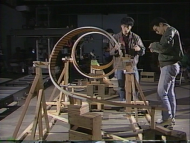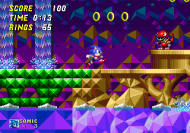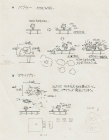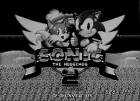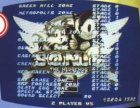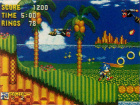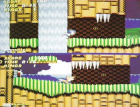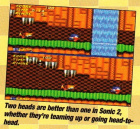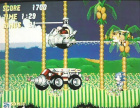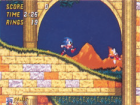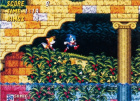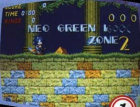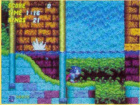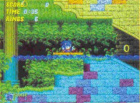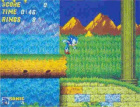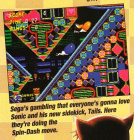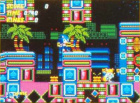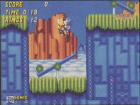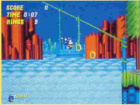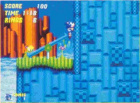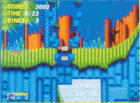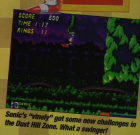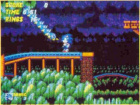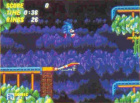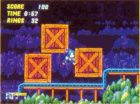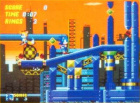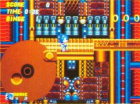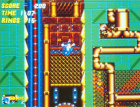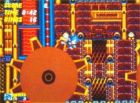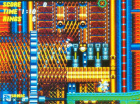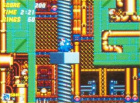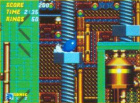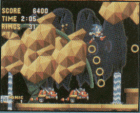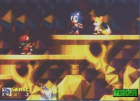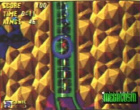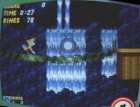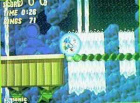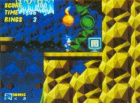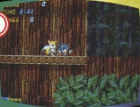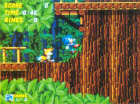Difference between revisions of "Sonic the Hedgehog 2 (16-bit)/Development"
From Sonic Retro
(not a description of prototype differences) |
(This is the "Tails" to the other page's "Sonic.") |
||
| Line 1: | Line 1: | ||
| − | ''[[Sonic the Hedgehog 2 (16-bit)|Sonic the Hedgehog 2]]'' | + | ''[[Sonic the Hedgehog 2 (16-bit)|Sonic the Hedgehog 2]]'' went through many ideas and changes during the development process. What follows is a collection of items related to the game's development. |
| − | == | + | ==Development Process== |
| − | |||
| − | + | [[File:S2 Commercial Behind The Scenes.png|right|thumb|190px|Behind the scenes of the ''Sonic the Hedgehog 2'' Japanese commercial.]] | |
| + | After the tremendous success of ''Sonic the Hedgehog'', it was only natural to expect a sequel to the game. Though many would have expected the same original team to spearhead the second entry in the series, right off the bat problems arose that would turn the production of ''Sonic the Hedgehog 2'' into the words legends are made of. [[Yuji Naka]], the man responsible for the engine of the first game, had run into issues with the management of Sega of Japan, the exact disagreements between him and the company unknown. Growing weary of the politics, Naka quit Sega, intending to look for work elsewhere. Back in the United States, [[Mark Cerny]], the man who had come up with the gaming classic ''Marble Madness'', had been hired by Sega to create a new gaming studio for the company, the [[Sega Technical Institute]]. The general idea behind the studio was to hire talented individuals who were only getting their start in the industry and teach them the ways of the gaming world, not only with the talent already established in the U.S. but by talent from Japan, as well. Placing advertisements in the local papers, the resumes began pouring in, with such people as [[Tom Payne]], [[Brenda Ross]], and future-creator of ''Spyro the Dragon'' [[Craig Stitt]] becoming employees of this new experiment in game development. | ||
| − | + | During the production of the original ''Sonic the Hedgehog'', Mark Cerny had already secured [[Hirokazu Yasuhara]], the director of that project, to come out to the United States and work for STI once his job back at Sega of Japan was done. However, when Cerny learned of Yuji Naka's departure from the company, he immediately called up his long-time friend, attempting to persuade him to come out to America as well and become a part of his venture. With the promise of a better salary, more executive power, and the potential for a Ferrari, Naka took Mark up on the offer, hiring back into the Sega fold.[http://info.sonicretro.org/Tim_Skelly_interview_by_ICEknight_(August_2004)] | |
| − | |||
| + | Though the American staff of STI cut their teeth on the game ''[[sega:Kid Chameleon|Kid Chameleon]]'', with the arrival of Naka, Yasuhara, and a handful of other Japanese staff members, Sega gave the team their first big assignment - the sequel to ''Sonic the Hedgehog''. With two of the three main people behind the success of the first game (the third, [[Naoto Ohshima]], choosing to stay behind and eventually direct ''[[Sonic the Hedgehog CD]]'') it only made sense to devote the entire studio to Sega's biggest game yet. | ||
| − | + | Filled to brim with ideas, one of the first elements the team decided on was that they wanted a new main character to be introduced in the game, someone who could be developed for a potential two player mode found within. An internal competition was held, and though many entries were submitted (including one from artist Craig Stitt for a flying turtle named "Boomer'") it was [[Yasushi Yamaguchi]] who won with his two-tailed fox character, [[Miles "Tails" Prower]]. Originally wanting the character to be named "Miles Prower," the rest of the team felt his name should simply be "Tails," to match the simplistic nature of Sonic's name. Unhappy with this idea, Yamaguchi (who became the lead zone artist in the game) decided to sneak the name "Miles Prower" into various concept art and in the game, making both names legitimate in the end. | |
| − | |||
| − | |||
| − | |||
| − | |||
| − | |||
| − | + | Being nothing less than ambitious, the original plan was to make a sprawling, 18-zone epic, revisiting the unique level tropes [[Sonic Team]] had created for the first game, putting their own spin on traditional platformer levels like desert and snow worlds, and even come up with some ideas that would be totally new. [[Emerald Hill]], [[Hill Top]], [[Oil Ocean]], [[Hidden Palace]], [[Dust Hill]] and the never-titled [[Winter Zone]] were some of the first levels to be worked on, the concept of time travel also being talked about in early production meetings. However, it became obvious early on that if they were to have the game ready for the Christmas season of 1992, that they could not get everything done. The time travel concept was dropped almost immediately, and Dust Hill and its winter counterpart were some of the first zones to be put on the chopping block, much to the chagrin of Brenda Ross, the artist responsible for their look.[http://info.sonicretro.org/Brenda_Ross_interview_by_Deviance_(February_2001)] | |
| − | [[ | ||
| − | ''Sonic the Hedgehog 2'' | + | Though the two sides of STI tried to work together, the language barrier proved to be too much at times. Most of the meetings for the direction of ''Sonic the Hedgehog 2'' were done in Japanese (Mark Cerny being fluent in the language), leaving the American side in the dust. Trying to mesh the two cultures and work ethics became a challenge in itself, with some members unable to get along with Yuji Naka's intense personality. Tom Payne, who himself never had any issues with the Japanese half of the team, recalled in an interview later the stark differences between the American mindset of a nine-to-five job and the Japanese mindset of working almost all hours of the night, with members like Yamaguchi and Yasuhara being extremely passionate with the quality of the whole: |
| − | == | + | {{quote|1=Well for me-- this was my first job so I only had Sonic 1 to go by & tried to make it match that style I'd say the it was Yamaguchi who laid out the look. He would stay all night & fix everything that we did wrong. Quite an amazing fellow.|2=Tom Payne, Zone Artist for ''Sonic the Hedgehog 2''[http://info.sonicretro.org/Tom_Payne_interview_by_SageXPO_(July_30,_2009)]}} |
| − | + | ||
| + | Even if tensions could rise as the leaders of the project demanded perfection, work on ''Sonic the Hedgehog 2'' continued unfettered. With each passing day, the hype behind the project grew more and more, immense pressure being put on the collective team. Not content with just the random screenshot from time to time, Sega wanted to advertise the game in as many ways possible. Getting in contact with the children's network Nickelodeon, a special cartridge was put together to be played on the gameshow [[Nick Arcade]], featuring an early version of Emerald Hill. This prototype, later referred to as the "[[Sonic the Hedgehog 2 (Nick Arcade prototype)|Nick Arcade prototype]]," was eventually leaked onto the Internet in 2006. Sometime after the airing of the show, another early build was put together to help drum up interest, being a playable build to the public at a New York toy show. However, security at the show was not up to snuff, and at the end the [[Yuji Naka interview by GameSpy (September 2005)|cartridge was stolen]]. Later to be known as the [[Sonic the Hedgehog 2 (Simon Wai prototype)|"Simon Wai" prototype]] (named after the man who discovered the ROM image on the Internet back in 1999) it was this build that was the source of many prerelease information related to the game. | ||
| + | |||
| + | [[Image:Hiddenpalaces2.png|right|thumb|190px|The much-discussed Hidden Palace Zone.]] | ||
| + | Even knowing early on they would not have enough time to work on everything they had set out to in the beginning, as the release date drew nearer it became more than obvious that the team would have barely enough time to finish the eleven zones that ended up in the final game. [[Genocide City Zone|Cyber City Zone]], a one-act level that was meant to follow [[Metropolis Zone]] (and was briefly called "Genocide City" but changed once the Japanese staff fully realized what the word meant) was scrapped, most of it converted into the third act of Metropolis Zone instead. The very last level to be removed was one of the first that had been worked on, the Hidden Palace Zone. Conceived as an area Sonic would warp to after collecting all seven Chaos Emeralds, deadlines forced the team to drop it, instead awarding the power of Super Sonic immediately after the seventh special stage was completed. | ||
| + | |||
| + | {{quote|1=My only complaint was that if art had to get cut out it always seemed to be the American's on the team who's art got cut. Sometimes this was because the art wasn't working, but on other occasions, I don't believe this was the case. (such as with Hidden Palace, although I never was happy with the far background).|2=Craig Stitt, Zone Artist for ''Sonic the Hedgehog 2''[http://info.sonicretro.org/Craig_Stitt_interview_by_ICEknight_(January_2001)]}} | ||
| + | |||
| + | The game was released simultaneously in the United States and Europe on "Sonic 2sday," a marketing campaign promoting the concept of "blast processing" was pursued, while back in Japan the campaign focused on the introduction of "Tails." The entire team, both American and Japanese, celebrated together on November 23rd, 1992, proud of the game that, against the odds, would not only be the biggest selling Sonic game on the Mega Drive, but the best selling game of the 16-bit era. | ||
| + | |||
| + | Also of note is the fact the game contained references to some of the biggest pop culture phenomenons on both sides of the Pacific. The Death Egg, Eggman's ultimate weapon in the game, was modeled after the Death Star, the superweapon featured in the ''Star Wars'' trilogy. Meanwhile, the seven Chaos Emeralds and the introduction of Super Sonic were homages to the well-known Chinese fable ''The Golden Warrior'' and its then-current interpretation being published in Japan, ''Dragon Ball.'' | ||
| + | |||
| + | The theme in the game that plays during the final cutscene, written by [[Masato Nakamura]], was later turned into a song for his band, [[DREAMS COME TRUE]]. Called [[SWEET SWEET SWEET]], the duet is sung with a real-life band backing the track. | ||
==Concept Art== | ==Concept Art== | ||
| − | |||
| − | |||
| − | |||
| − | |||
| − | |||
| − | |||
| − | |||
| − | |||
| − | === | + | ===Enemy Concept Art=== |
<gallery widths="148px" heights="140px" perrow="4"> | <gallery widths="148px" heights="140px" perrow="4"> | ||
| − | File: | + | File:Sket banper.png|Concept art of [[Banper]]. |
| − | + | File:Sket fishfrog.png|Concept art of the [[Frog]]. | |
| − | + | File:Sket bubbler.png|Concept art of [[Bubbler]] and [[Bubbler's Mother]]. | |
| − | + | File:Sket bee.png|Concept art of [[Bee]]. | |
| − | + | File:Sket snail.png|Concept art of a snail-like enemy. | |
| − | File:S2crawlconcept.JPG|Concept art of | + | File:S2crawlconcept.JPG|Concept art of [[Crawl]]. |
| − | File:S2crawlconcept2.JPG|More Crawl | + | File:S2crawlconcept2.JPG|More Crawl concept art. |
| − | File:S2fishconcept.JPG|Early concept art for | + | File:S2fishconcept.JPG|Early concept art for [[Masher]]. |
File:S2fishconcept2.JPG|Paper devoted to the Masher badnik. | File:S2fishconcept2.JPG|Paper devoted to the Masher badnik. | ||
| − | File:S2badnikconcepts.jpg | + | File:S2badnikconcepts.jpg|Features the [[Frog]]. |
File:S2badnikconcepts2.jpg | File:S2badnikconcepts2.jpg | ||
| − | File:S2badnikconcepts3.jpg | + | File:S2badnikconcepts3.jpg|Concept art of [[Bubbler's Mother]]. |
| − | File:S2badnikconcepts4.jpg | + | File:S2badnikconcepts4.jpg|More concept art of the snail-like enemy. |
File:S2badnikconcepts5.jpg | File:S2badnikconcepts5.jpg | ||
File:S2badnikconcepts6.jpg | File:S2badnikconcepts6.jpg | ||
| Line 55: | Line 53: | ||
File:S2badnikconcepts8.jpg | File:S2badnikconcepts8.jpg | ||
File:S2badnikconcepts9.jpg | File:S2badnikconcepts9.jpg | ||
| − | File:S2badnikconcepts10.jpg | + | File:S2badnikconcepts10.jpg|Possible enemy ideas for Dust Hill. |
File:S2badnikconcepts11.jpg | File:S2badnikconcepts11.jpg | ||
| − | File:S2enemyconcepts12.JPG | + | File:S2enemyconcepts12.JPG|More of the Frog badnik. |
File:S2enemyconcepts13.JPG | File:S2enemyconcepts13.JPG | ||
File:S2enemyconcepts14.JPG | File:S2enemyconcepts14.JPG | ||
| − | File:S2enemyconcepts15.JPG | + | File:S2enemyconcepts15.JPG|More of the snail-like enemy. |
File:S2enemyconcepts16.JPG | File:S2enemyconcepts16.JPG | ||
File:S2enemyconcepts17.JPG | File:S2enemyconcepts17.JPG | ||
File:S2enemyconcepts18.JPG | File:S2enemyconcepts18.JPG | ||
| + | File:Snailconcept.JPG|Concept art for [[Snail]]. | ||
| + | File:Snailconcept2.JPG|Descriptions of the Snail enemy. | ||
| + | File:Tricerabotconcept.JPG|Concept art of [[Stego]]. | ||
| + | File:Tricerabotconcept2.JPG|Further art of Stego. | ||
| + | File:Waspconcept.JPG|Concept art of [[Bee]]. | ||
| + | |||
</gallery> | </gallery> | ||
| − | === | + | ===Level Concept Art=== |
| − | |||
| − | |||
| − | |||
| − | |||
| − | |||
| − | |||
| − | |||
| − | |||
====Metropolis Zone==== | ====Metropolis Zone==== | ||
| + | |||
<gallery widths="148px" heights="140px" perrow="4"> | <gallery widths="148px" heights="140px" perrow="4"> | ||
| − | Image:Metropolis concept.jpg|An early piece of concept art for [[Metropolis Zone]] | + | Image:Metropolis concept.jpg|An early piece of concept art for [[Metropolis Zone]]. |
File:S2metropolisconcepts.jpg|Early concept art. | File:S2metropolisconcepts.jpg|Early concept art. | ||
| − | File:S2metropolisconcepts2.jpg|Early concept art. Text humorously refer to the level as Sonic sweat shop. | + | File:S2metropolisconcepts2.jpg|Early concept art. Text humorously refer to the level as "Sonic sweat shop." |
File:S2metrpolisconcepts3.jpg|Early concept art. Windows can be seen. | File:S2metrpolisconcepts3.jpg|Early concept art. Windows can be seen. | ||
File:S2metropolisfgconcept.jpg|Early concept art of the foreground. | File:S2metropolisfgconcept.jpg|Early concept art of the foreground. | ||
File:S2metropolisbgconcept.jpg|Early concept art of the background. Furnaces can be seen. | File:S2metropolisbgconcept.jpg|Early concept art of the background. Furnaces can be seen. | ||
| − | File:Rhombusds.JPG|The | + | File:Rhombusds.JPG|The unused diagonal elevators. |
File:Metropolis1a.jpg|Early Act 1 map. Has diagonally slanted rotating steel drums. Very different from final. Only two things seem very similar to final; the general positioning of the starting area, and the short downward ramp leading to a flat area with the end sign. | File:Metropolis1a.jpg|Early Act 1 map. Has diagonally slanted rotating steel drums. Very different from final. Only two things seem very similar to final; the general positioning of the starting area, and the short downward ramp leading to a flat area with the end sign. | ||
| − | File:Metropolis2a.jpg|Early Act 2 map. Has giant crusher. Very different from final. Aside from the immediate starting area and an area with a half-loop leading to a ramp in the top-left, almost nothing | + | File:Metropolis2a.jpg|Early Act 2 map. Has giant crusher. Very different from final. Aside from the immediate starting area and an area with a half-loop leading to a ramp in the top-left, almost nothing recognizable remains. |
File:Metropolismapx.jpg|Another Act 2 map. | File:Metropolismapx.jpg|Another Act 2 map. | ||
File:Metropolis3a.jpg|Early Act 3 map. Has a diagonal elevator. | File:Metropolis3a.jpg|Early Act 3 map. Has a diagonal elevator. | ||
| − | File:Metropolis3b.jpg|Early Act 3 map. | + | File:Metropolis3b.jpg|Early Act 3 map. Features a horizontal spike obstacle, similar to the ones removed from [[Marble Zone]] of the first game. |
| − | File:Metropolis3c.jpg|Early Act 3 map | + | File:Metropolis3c.jpg|Early Act 3 map. |
</gallery> | </gallery> | ||
| − | ==== | + | ====Assorted Levels==== |
| + | |||
<gallery widths="148px" heights="140px" perrow="4"> | <gallery widths="148px" heights="140px" perrow="4"> | ||
| + | Image:S2concept-1.png|Sonic and Tails near a large ramp. Most likely the [[Emerald Hill Zone]]. | ||
| + | Image:S2concept-2.png|The familiar "moving blocks" area from [[Chemical Plant Zone]]. | ||
Image:S2concept-3.png|Various ideas for [[Sky Chase Zone]] and possibly [[Hill Top Zone]]. | Image:S2concept-3.png|Various ideas for [[Sky Chase Zone]] and possibly [[Hill Top Zone]]. | ||
| + | File:Cybercity concept.jpg|Concept art for the scrapped [[Genocide City Zone|Cyber City Zone]]. | ||
</gallery> | </gallery> | ||
| Line 106: | Line 107: | ||
</gallery> | </gallery> | ||
| − | == | + | ===Miscellanious Documents=== |
| − | + | ||
| − | === | + | <gallery widths="148px" heights="140px" perrow="4"> |
| + | File:S2spritesystem.jpg|Explanation of the sprite system. | ||
| + | File:S2TASKLIST.jpg|Task list from which Tom Payne worked with. | ||
| + | File:S2paldata.jpg|File dealing with the palette data of the game. | ||
| + | File:S2lavabubds.JPG|Information about a lava bubbling animation. | ||
| + | File:S2sludgehog.jpg|A joke image of Sonic brandishing a gun, knowingly foreshadowing the game ''[[Shadow the Hedgehog (game)|Shadow the Hedgehog]]''. | ||
| + | </gallery> | ||
| + | |||
| + | ==Promotional Screenshots== | ||
| + | |||
| + | ===Title Screen=== | ||
<gallery widths="140px" heights="140px" perrow="4"> | <gallery widths="140px" heights="140px" perrow="4"> | ||
| − | Image:mag_compare8a.png| | + | Image:mag_compare8a.png|The original title screen to ''Sonic 2'', as pictured in the U.S. manual. |
Image:mag gamepro 2.jpg|Same Title screen in color. This one is a bit older as it lacks the menu options. | Image:mag gamepro 2.jpg|Same Title screen in color. This one is a bit older as it lacks the menu options. | ||
| − | Image:mag_compare10a.jpg| | + | Image:mag_compare10a.jpg|An early level select, similar to [[Sonic 1]]'s. Features names of zones ultimately cut from the final product. |
</gallery> | </gallery> | ||
===Emerald Hill Zone=== | ===Emerald Hill Zone=== | ||
<gallery widths="140px" heights="140px" perrow="4"> | <gallery widths="140px" heights="140px" perrow="4"> | ||
| − | Image:mag_compare4a.jpg|An early mockup of the zone with an off-center Sonic. Note the [[Green Hill Zone]] clouds in the background | + | Image:mag_compare4a.jpg|An early mockup of the zone with an off-center Sonic. Note the [[Green Hill Zone]] clouds in the background and the Sonic 1 HUD. |
Image:EHZ mockup hires.jpg|Better quality version of the mockup, albeit with the top and bottom missing. | Image:EHZ mockup hires.jpg|Better quality version of the mockup, albeit with the top and bottom missing. | ||
| − | Image:mag_compare14a.jpg|Tails | + | Image:mag_compare14a.jpg|"Tails" life counter says "Sonic". |
| − | Image:mag_compare21a.jpg| | + | Image:mag_compare21a.jpg| |
| − | Image:mag_compare25a.png| | + | Image:mag_compare25a.png|A score counter is visible, removed from the final 2-player mode. |
Image:mag_compare15a.jpg|Eggman appears to be flying straight down as opposed to diagonally. This seems to have been from a later prototype as we see Tails flying in from the top, which was not implemented in the Simon Wai prototype. | Image:mag_compare15a.jpg|Eggman appears to be flying straight down as opposed to diagonally. This seems to have been from a later prototype as we see Tails flying in from the top, which was not implemented in the Simon Wai prototype. | ||
</gallery> | </gallery> | ||
| Line 127: | Line 138: | ||
===Aquatic Ruin Zone=== | ===Aquatic Ruin Zone=== | ||
<gallery widths="140px" heights="140px" perrow="4"> | <gallery widths="140px" heights="140px" perrow="4"> | ||
| − | Image:ARZ ramp.png| | + | Image:ARZ ramp.png|Featuring the early walking animation. |
| − | Image:ARZ ramp2.png | + | Image:ARZ ramp2.png |
| − | Image:mag_compare12a.jpg| | + | Image:mag_compare12a.jpg|A broken title card, loading bubble graphics in place of letters. Uses the early level name "Neo Green Hill Zone". |
Image:ARZ underwater.jpg|Here Sonic's animations seem to be final. | Image:ARZ underwater.jpg|Here Sonic's animations seem to be final. | ||
Image:ARZ floating log.jpg|Log floating on water. | Image:ARZ floating log.jpg|Log floating on water. | ||
| Line 137: | Line 148: | ||
===Casino Night Zone=== | ===Casino Night Zone=== | ||
<gallery widths="140px" heights="140px" perrow="4"> | <gallery widths="140px" heights="140px" perrow="4"> | ||
| − | Image:mag_compare6a.jpg| | + | Image:mag_compare6a.jpg|A [[Casino Night Zone|Casino Night]] with a vastly different color and art style, similar to the one featured in the "Simon Wai prototype." |
| − | Image:CNZ pink.jpg|This design also seems to be more complete than in the | + | Image:CNZ pink.jpg|This design also seems to be more complete than in the prototype. |
</gallery> | </gallery> | ||
===Hill Top Zone=== | ===Hill Top Zone=== | ||
<gallery widths="140px" heights="140px" perrow="4"> | <gallery widths="140px" heights="140px" perrow="4"> | ||
| − | Image:mag_compare9a.gif| | + | Image:mag_compare9a.gif|Generic green balls instead of enemies. This is consistent with the [[Sonic the Hedgehog 2 Nick Arcade Prototype|"Nick Arcade" prototype]]. |
Image:HTZ ride.jpg| | Image:HTZ ride.jpg| | ||
Image:HTZ magma.jpg| | Image:HTZ magma.jpg| | ||
| Line 152: | Line 163: | ||
===Mystic Cave Zone=== | ===Mystic Cave Zone=== | ||
<gallery widths="140px" heights="140px" perrow="4"> | <gallery widths="140px" heights="140px" perrow="4"> | ||
| − | Image:mag gamepro 3.jpg|Mystic Cave | + | Image:mag gamepro 3.jpg|[[Mystic Cave Zone]] mistakenly referred to as "Dust Hill Zone," due to early level select titles. |
Image:MCZ enemy.jpg| | Image:MCZ enemy.jpg| | ||
Image:MCZ plank.jpg| | Image:MCZ plank.jpg| | ||
| Line 161: | Line 172: | ||
===Oil Ocean Zone=== | ===Oil Ocean Zone=== | ||
<gallery widths="140px" heights="140px" perrow="4"> | <gallery widths="140px" heights="140px" perrow="4"> | ||
| − | Image:OOZ sun.png| | + | Image:OOZ sun.png|An earlier sun in the background to [[Oil Ocean Zone]]. Featured in the "Simon Wai prototype." |
| − | Image:OOZ walk.png|More of the prototype walking animation | + | Image:OOZ walk.png|More of the prototype walking animation, plus a switch that causes a ridable ball to appear. |
| − | Image:OOZ ball.jpg| | + | Image:OOZ ball.jpg|The ridable ball. Only appear in the debug mode in the final game.. |
</gallery> | </gallery> | ||
| Line 178: | Line 189: | ||
===Hidden Palace Zone=== | ===Hidden Palace Zone=== | ||
<gallery widths="140px" heights="140px" perrow="4"> | <gallery widths="140px" heights="140px" perrow="4"> | ||
| − | Image:mag_compare1a.jpg| | + | Image:mag_compare1a.jpg|An early mockup screenshot of [[Hidden Palace Zone]]. Sonic is off center and there is a background not seen in any later screenshots. |
Image:HPZ diffBG.png|A different scan of the previous image. | Image:HPZ diffBG.png|A different scan of the previous image. | ||
| − | Image:HPZ Bat.jpg|Bat Badniks which were removed along with the zone. | + | Image:HPZ Bat.jpg|[[BBat|Bat Badniks]] which were removed along with the zone. |
| − | Image:HPZ Dino.jpg| | + | Image:HPZ Dino.jpg|Featuring [[Redz]]. |
| − | Image:mag_compare2a.jpg|The shield glows through tube - something that would be | + | Image:mag_compare2a.jpg|The shield glows through tube - something that would be fixed in later versions. |
| − | Image:mag_compare7a.gif|This screenshot has a green watermark | + | Image:mag_compare7a.gif|This screenshot has a green watermark above lives icon, and is not part of the zone. |
| − | Image:mag_compare13a.jpg | + | Image:mag_compare13a.jpg |
| − | Image:HPZ Bridge.JPG | + | Image:HPZ Bridge.JPG |
| − | File:HPZ monitor.jpg|The infamous Tails 1-up monitor | + | File:HPZ monitor.jpg|The infamous "Tails" 1-up [[monitor]]. |
</gallery> | </gallery> | ||
===Wood Zone=== | ===Wood Zone=== | ||
<gallery widths="140px" heights="140px" perrow="4"> | <gallery widths="140px" heights="140px" perrow="4"> | ||
| − | Image:mag_compare11a.jpg|Sonic | + | Image:mag_compare11a.jpg|Sonic impatiently waiting in the scrapped [[Wood Zone]]. |
| − | Image:S2 WoodZone.jpg | + | Image:S2 WoodZone.jpg |
</gallery> | </gallery> | ||
===Dust Hill Zone=== | ===Dust Hill Zone=== | ||
<gallery widths="140px" heights="140px" perrow="4"> | <gallery widths="140px" heights="140px" perrow="4"> | ||
| − | Image:mag_compare3a.jpg|The only shot of Dust Hill Zone | + | Image:mag_compare3a.jpg|The only shot of [[Dust Hill Zone]] "[[Gator]]" exists within early prototypes of the game. |
| + | File:DesertlevelCorrectColor.JPG|A color-corrected version of the same image. | ||
</gallery> | </gallery> | ||
| + | |||
| + | ==See Also== | ||
| + | *[[S2Beta:Main Page|The Sonic 2 Beta Wiki]] - A detailed look at the "Simon Wai protoype," pieced together by [[Simon Wai]] and [[LocalH]]. | ||
{{S2MDOmni}} | {{S2MDOmni}} | ||
[[Category:Game Development|Sonic the Hedgehog 2 (16-bit)]] | [[Category:Game Development|Sonic the Hedgehog 2 (16-bit)]] | ||
Revision as of 00:00, 21 March 2011
Sonic the Hedgehog 2 went through many ideas and changes during the development process. What follows is a collection of items related to the game's development.
Development Process
After the tremendous success of Sonic the Hedgehog, it was only natural to expect a sequel to the game. Though many would have expected the same original team to spearhead the second entry in the series, right off the bat problems arose that would turn the production of Sonic the Hedgehog 2 into the words legends are made of. Yuji Naka, the man responsible for the engine of the first game, had run into issues with the management of Sega of Japan, the exact disagreements between him and the company unknown. Growing weary of the politics, Naka quit Sega, intending to look for work elsewhere. Back in the United States, Mark Cerny, the man who had come up with the gaming classic Marble Madness, had been hired by Sega to create a new gaming studio for the company, the Sega Technical Institute. The general idea behind the studio was to hire talented individuals who were only getting their start in the industry and teach them the ways of the gaming world, not only with the talent already established in the U.S. but by talent from Japan, as well. Placing advertisements in the local papers, the resumes began pouring in, with such people as Tom Payne, Brenda Ross, and future-creator of Spyro the Dragon Craig Stitt becoming employees of this new experiment in game development.
During the production of the original Sonic the Hedgehog, Mark Cerny had already secured Hirokazu Yasuhara, the director of that project, to come out to the United States and work for STI once his job back at Sega of Japan was done. However, when Cerny learned of Yuji Naka's departure from the company, he immediately called up his long-time friend, attempting to persuade him to come out to America as well and become a part of his venture. With the promise of a better salary, more executive power, and the potential for a Ferrari, Naka took Mark up on the offer, hiring back into the Sega fold.[1]
Though the American staff of STI cut their teeth on the game Kid Chameleon, with the arrival of Naka, Yasuhara, and a handful of other Japanese staff members, Sega gave the team their first big assignment - the sequel to Sonic the Hedgehog. With two of the three main people behind the success of the first game (the third, Naoto Ohshima, choosing to stay behind and eventually direct Sonic the Hedgehog CD) it only made sense to devote the entire studio to Sega's biggest game yet.
Filled to brim with ideas, one of the first elements the team decided on was that they wanted a new main character to be introduced in the game, someone who could be developed for a potential two player mode found within. An internal competition was held, and though many entries were submitted (including one from artist Craig Stitt for a flying turtle named "Boomer'") it was Yasushi Yamaguchi who won with his two-tailed fox character, Miles "Tails" Prower. Originally wanting the character to be named "Miles Prower," the rest of the team felt his name should simply be "Tails," to match the simplistic nature of Sonic's name. Unhappy with this idea, Yamaguchi (who became the lead zone artist in the game) decided to sneak the name "Miles Prower" into various concept art and in the game, making both names legitimate in the end.
Being nothing less than ambitious, the original plan was to make a sprawling, 18-zone epic, revisiting the unique level tropes Sonic Team had created for the first game, putting their own spin on traditional platformer levels like desert and snow worlds, and even come up with some ideas that would be totally new. Emerald Hill, Hill Top, Oil Ocean, Hidden Palace, Dust Hill and the never-titled Winter Zone were some of the first levels to be worked on, the concept of time travel also being talked about in early production meetings. However, it became obvious early on that if they were to have the game ready for the Christmas season of 1992, that they could not get everything done. The time travel concept was dropped almost immediately, and Dust Hill and its winter counterpart were some of the first zones to be put on the chopping block, much to the chagrin of Brenda Ross, the artist responsible for their look.[2]
Though the two sides of STI tried to work together, the language barrier proved to be too much at times. Most of the meetings for the direction of Sonic the Hedgehog 2 were done in Japanese (Mark Cerny being fluent in the language), leaving the American side in the dust. Trying to mesh the two cultures and work ethics became a challenge in itself, with some members unable to get along with Yuji Naka's intense personality. Tom Payne, who himself never had any issues with the Japanese half of the team, recalled in an interview later the stark differences between the American mindset of a nine-to-five job and the Japanese mindset of working almost all hours of the night, with members like Yamaguchi and Yasuhara being extremely passionate with the quality of the whole:
| “ | Well for me-- this was my first job so I only had Sonic 1 to go by & tried to make it match that style I'd say the it was Yamaguchi who laid out the look. He would stay all night & fix everything that we did wrong. Quite an amazing fellow. | „ |
| — Tom Payne, Zone Artist for Sonic the Hedgehog 2[3] | ||
Even if tensions could rise as the leaders of the project demanded perfection, work on Sonic the Hedgehog 2 continued unfettered. With each passing day, the hype behind the project grew more and more, immense pressure being put on the collective team. Not content with just the random screenshot from time to time, Sega wanted to advertise the game in as many ways possible. Getting in contact with the children's network Nickelodeon, a special cartridge was put together to be played on the gameshow Nick Arcade, featuring an early version of Emerald Hill. This prototype, later referred to as the "Nick Arcade prototype," was eventually leaked onto the Internet in 2006. Sometime after the airing of the show, another early build was put together to help drum up interest, being a playable build to the public at a New York toy show. However, security at the show was not up to snuff, and at the end the cartridge was stolen. Later to be known as the "Simon Wai" prototype (named after the man who discovered the ROM image on the Internet back in 1999) it was this build that was the source of many prerelease information related to the game.
Even knowing early on they would not have enough time to work on everything they had set out to in the beginning, as the release date drew nearer it became more than obvious that the team would have barely enough time to finish the eleven zones that ended up in the final game. Cyber City Zone, a one-act level that was meant to follow Metropolis Zone (and was briefly called "Genocide City" but changed once the Japanese staff fully realized what the word meant) was scrapped, most of it converted into the third act of Metropolis Zone instead. The very last level to be removed was one of the first that had been worked on, the Hidden Palace Zone. Conceived as an area Sonic would warp to after collecting all seven Chaos Emeralds, deadlines forced the team to drop it, instead awarding the power of Super Sonic immediately after the seventh special stage was completed.
| “ | My only complaint was that if art had to get cut out it always seemed to be the American's on the team who's art got cut. Sometimes this was because the art wasn't working, but on other occasions, I don't believe this was the case. (such as with Hidden Palace, although I never was happy with the far background). | „ |
| — Craig Stitt, Zone Artist for Sonic the Hedgehog 2[4] | ||
The game was released simultaneously in the United States and Europe on "Sonic 2sday," a marketing campaign promoting the concept of "blast processing" was pursued, while back in Japan the campaign focused on the introduction of "Tails." The entire team, both American and Japanese, celebrated together on November 23rd, 1992, proud of the game that, against the odds, would not only be the biggest selling Sonic game on the Mega Drive, but the best selling game of the 16-bit era.
Also of note is the fact the game contained references to some of the biggest pop culture phenomenons on both sides of the Pacific. The Death Egg, Eggman's ultimate weapon in the game, was modeled after the Death Star, the superweapon featured in the Star Wars trilogy. Meanwhile, the seven Chaos Emeralds and the introduction of Super Sonic were homages to the well-known Chinese fable The Golden Warrior and its then-current interpretation being published in Japan, Dragon Ball.
The theme in the game that plays during the final cutscene, written by Masato Nakamura, was later turned into a song for his band, DREAMS COME TRUE. Called SWEET SWEET SWEET, the duet is sung with a real-life band backing the track.
Concept Art
Enemy Concept Art
- Sket banper.png
Concept art of Banper.
- Sket fishfrog.png
Concept art of the Frog.
Concept art of Bubbler and Bubbler's Mother.
- Sket bee.png
Concept art of Bee.
- Sket snail.png
Concept art of a snail-like enemy.
- S2crawlconcept.JPG
Concept art of Crawl.
- S2crawlconcept2.JPG
More Crawl concept art.
- S2fishconcept.JPG
Early concept art for Masher.
- S2fishconcept2.JPG
Paper devoted to the Masher badnik.
- S2badnikconcepts.jpg
Features the Frog.
- S2badnikconcepts2.jpg
- S2badnikconcepts3.jpg
Concept art of Bubbler's Mother.
- S2badnikconcepts4.jpg
More concept art of the snail-like enemy.
- S2badnikconcepts5.jpg
- S2badnikconcepts6.jpg
- S2badnikconcepts7.jpg
- S2badnikconcepts8.jpg
- S2badnikconcepts9.jpg
- S2badnikconcepts10.jpg
Possible enemy ideas for Dust Hill.
- S2badnikconcepts11.jpg
- S2enemyconcepts12.JPG
More of the Frog badnik.
- S2enemyconcepts13.JPG
- S2enemyconcepts14.JPG
- S2enemyconcepts15.JPG
More of the snail-like enemy.
- S2enemyconcepts16.JPG
- S2enemyconcepts17.JPG
- S2enemyconcepts18.JPG
- Snailconcept.JPG
Concept art for Snail.
- Snailconcept2.JPG
Descriptions of the Snail enemy.
- Tricerabotconcept.JPG
Concept art of Stego.
- Tricerabotconcept2.JPG
Further art of Stego.
- Waspconcept.JPG
Concept art of Bee.
Level Concept Art
Metropolis Zone
- Metropolis concept.jpg
An early piece of concept art for Metropolis Zone.
- S2metropolisconcepts.jpg
Early concept art.
- S2metropolisconcepts2.jpg
Early concept art. Text humorously refer to the level as "Sonic sweat shop."
- S2metrpolisconcepts3.jpg
Early concept art. Windows can be seen.
- S2metropolisfgconcept.jpg
Early concept art of the foreground.
- S2metropolisbgconcept.jpg
Early concept art of the background. Furnaces can be seen.
- Rhombusds.JPG
The unused diagonal elevators.
- Metropolis1a.jpg
Early Act 1 map. Has diagonally slanted rotating steel drums. Very different from final. Only two things seem very similar to final; the general positioning of the starting area, and the short downward ramp leading to a flat area with the end sign.
- Metropolis2a.jpg
Early Act 2 map. Has giant crusher. Very different from final. Aside from the immediate starting area and an area with a half-loop leading to a ramp in the top-left, almost nothing recognizable remains.
- Metropolismapx.jpg
Another Act 2 map.
- Metropolis3a.jpg
Early Act 3 map. Has a diagonal elevator.
- Metropolis3b.jpg
Early Act 3 map. Features a horizontal spike obstacle, similar to the ones removed from Marble Zone of the first game.
- Metropolis3c.jpg
Early Act 3 map.
Assorted Levels
Sonic and Tails near a large ramp. Most likely the Emerald Hill Zone.
The familiar "moving blocks" area from Chemical Plant Zone.
Various ideas for Sky Chase Zone and possibly Hill Top Zone.
- Cybercity concept.jpg
Concept art for the scrapped Cyber City Zone.
Objects
- Sket ball.png
A bouncing ball which was scrapped before release. Its sprites can actually be found in a prototype version in Oil Ocean Zone.
- RollingBallConceptArt.jpg
More bouncing ball concept art. Taken from this file.
- S2ballframes.jpg
Page dealing with the frames of the bouncing ball.
- S2ballthingy.jpg
Artwork of the bouncing ball in full color.
Miscellanious Documents
- S2spritesystem.jpg
Explanation of the sprite system.
- S2TASKLIST.jpg
Task list from which Tom Payne worked with.
- S2paldata.jpg
File dealing with the palette data of the game.
- S2lavabubds.JPG
Information about a lava bubbling animation.
- S2sludgehog.jpg
A joke image of Sonic brandishing a gun, knowingly foreshadowing the game Shadow the Hedgehog.
Promotional Screenshots
Title Screen
An early level select, similar to Sonic 1's. Features names of zones ultimately cut from the final product.
Emerald Hill Zone
An early mockup of the zone with an off-center Sonic. Note the Green Hill Zone clouds in the background and the Sonic 1 HUD.
- Mag compare25a.png
A score counter is visible, removed from the final 2-player mode.
Aquatic Ruin Zone
Casino Night Zone
A Casino Night with a vastly different color and art style, similar to the one featured in the "Simon Wai prototype."
Hill Top Zone
Generic green balls instead of enemies. This is consistent with the "Nick Arcade" prototype.
Mystic Cave Zone
Mystic Cave Zone mistakenly referred to as "Dust Hill Zone," due to early level select titles.
Oil Ocean Zone
- OOZ sun.png
An earlier sun in the background to Oil Ocean Zone. Featured in the "Simon Wai prototype."
- OOZ walk.png
More of the prototype walking animation, plus a switch that causes a ridable ball to appear.
Metropolis Zone
Hidden Palace Zone
An early mockup screenshot of Hidden Palace Zone. Sonic is off center and there is a background not seen in any later screenshots.
Bat Badniks which were removed along with the zone.
Featuring Redz.
- Mag compare7a.gif
This screenshot has a green watermark above lives icon, and is not part of the zone.
The infamous "Tails" 1-up monitor.
Wood Zone
Sonic impatiently waiting in the scrapped Wood Zone.
Dust Hill Zone
The only shot of Dust Hill Zone "Gator" exists within early prototypes of the game.
See Also
- The Sonic 2 Beta Wiki - A detailed look at the "Simon Wai protoype," pieced together by Simon Wai and LocalH.
| Sonic the Hedgehog 2 (16-bit) | |
|---|---|
|
Main page (KiS2|2013|3D|Ages) Manuals Development |
show;hide
Scrapped Levels: Scrapped Enemies: 2013 remake only: 2013 remake only: Knuckles in Sonic 2 Prototypes: |
